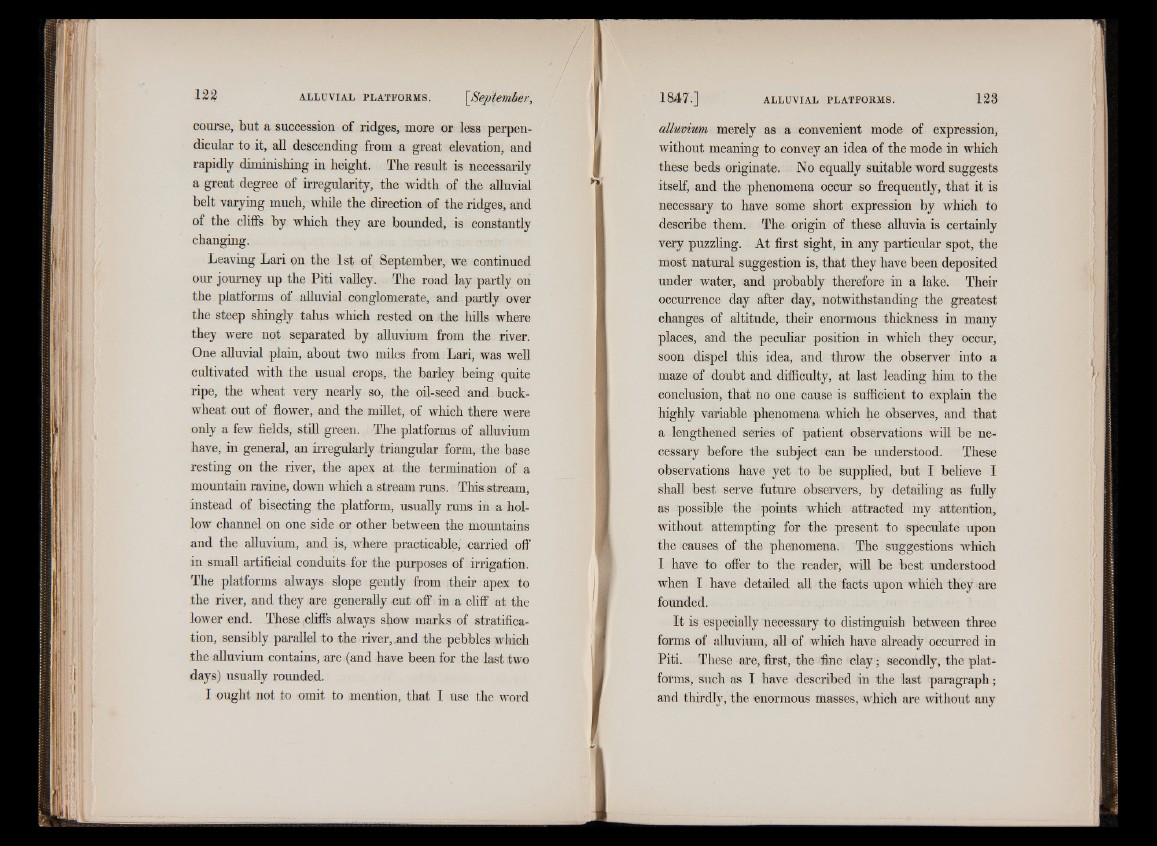
course, but a succession of ridges, more or less perpendicular
to it, all descending from a great elevation, and
rapidly diminishing in height. The result is necessarily
a great degree of irregularity, the width of the alluvial
belt varying much, while the direction of the ridges, and
of the cliffs by which they are bounded, is constantly
changing.
Leaving Lari on the 1st of September, we continued
our journey up the Piti valley. The road lay partly on
the platforms of alluvial conglomerate, and partly over
the steep shingly talus which rested on the hills where
they were not separated by alluvium from the river.
One alluvial plain, about two miles from Lari, was well
cultivated with the usual crops, the barley being quite
ripe, the wheat very nearly so, the oil-seed and buckwheat
out of flower, and the millet, of which there were
only a few fields, still green. The platforms of alluvium
have, in general, an irregularly triangular form, the base
resting on the river, the apex at the termination of a
mountain ravine, down which a stream runs. This stream,
instead of bisecting the platform, usually runs in a hollow
channel on one side or other between the mountains
and the alluvium, and is, where practicable, carried off
in small artificial conduits for the purposes of irrigation.
The platforms always slope gently from their apex to
the river, and they are generally cut off in a cliff at the
lower end. These cliffs always show marks of stratification,
sensibly parallel to the river, and the pebbles which
the alluvium contains, are (and have been for the last two
days) usually rounded.
I ought not to omit to mention, that I use the word
alluvium merely as a convenient mode of expression,
without meaning to convey an idea of the mode in which
these beds originate. No equally suitable word suggests
itself, and the phenomena occur so frequently, that it is
necessary to have some short expression by which to
describe them. The origin of these alluvia is certainly
very puzzling. At first sight, in any particular spot, the
most natural suggestion is, that they have been deposited
under water, and probably therefore in a lake. Their
occurrence day after day, notwithstanding the greatest
changes of altitude, their enormous thickness in many
places, and the peculiar position in which they occur,
soon dispel this idea, and throw the observer into a
maze of doubt and difficulty, at last leading him to the
conclusion, that no one cause is sufficient to explain the
highly variable phenomena which he observes, and that
a lengthened series of patient observations will be necessary
before the subject can be understood. These
observations have yet to be supplied, but I believe I
shall best serve future observers, by detailing as fully
as possible the points which attracted my attention,
without attempting for the present to speculate upon
the causes of the phenomena. The suggestions which
I have to offer to the reader, will be best understood
when I have detailed all the facts upon which they are
founded.
It is especially necessary to distinguish between three
forms of alluvium, all of which have already occurred in
Piti. These are, first, the fine clay; secondly, the platforms,
such as I have described in the last paragraph ;
and thirdly, the enormous masses, which are without any